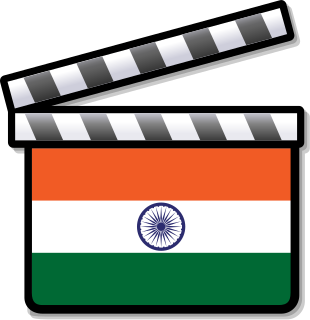
Hindi cinema, often known as Bollywood and formerly as Bombay cinema, is the Indian Hindi-language film industry based in Mumbai. The term is a portmanteau of "Bombay" and "Hollywood". The industry is related to Cinema of South India and other Indian film industries, making up Indian cinema—the world's largest by number of feature films produced.

The cinema of India consists of films produced in India. Cinema is immensely popular in India: every year, more than 1800 films are produced collectively in the various languages of India. Mumbai, Chennai, Kolkata, Hyderabad, Kochi, Bangalore, Bhubaneshwar-Cuttack and Guwahati are the major centres of film production in India. As of 2018, India ranked first in terms of annual film output. In 2015, India had a total box office gross of US$2.1 billion, the third largest in the world. The overall revenue of Indian cinema reached US$2.7 billion in 2019.

Bandra also known as Vandre is an upscale coastal suburb located in Mumbai, India. The suburb is located to the immediate north of the Mithi River, which separates Bandra from Mumbai City district. It is the third-largest commercial hub in Maharashtra, after Mumbai & Pune, primarily aided by the Bandra Kurla Complex. Originally, Bandra was larger in size when present day Khar was also a part of it. Almost a century ago, it was considered too large a suburb to be served by one railway station. Therefore, the Khar Road railway station was established in 1924, to give the northern part of Bandra closer access to the Western Railway line. This eventually led to Khar being considered a separate suburb. But to this day, the two adjoined suburbs make up one homogenous zone. Several prominent citizens of Mumbai, who are active in Bollywood, Media, Cricket and Politics reside in this area.

Mughal-e-Azam is a Hindustani-language 1960 Indian epic historical drama film directed by K. Asif and produced by Shapoorji Pallonji. Starring Prithviraj Kapoor, Madhubala, Durga Khote and Dilip Kumar, it follows the love affair between Mughal Prince Salim and Anarkali, a court dancer. Salim's father, Emperor Akbar, disapproves of the relationship, which leads to a war between father and son.

Bimal Roy was an Indian film director. He is particularly noted for his realistic and socialistic films such as Do Bigha Zamin, Parineeta, Biraj Bahu, Devdas, Madhumati, Sujata, Parakh and Bandini, making him an important director of Hindi cinema. Inspired by Italian neo-realistic cinema, he made Do Bigha Zamin after watching Vittorio De Sica's Bicycle Thieves (1948). His work is particularly known for his mise en scène which he employed to portray realism. He won a number of awards throughout his career, including eleven Filmfare Awards, two National Film Awards, and the International Prize of the Cannes Film Festival. Madhumati won 9 Filmfare Awards in 1958, a record held for 37 years.
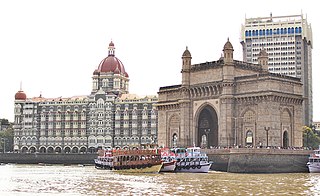
A resident of Mumbai is called a Mumbaikar. People prefer to stay close to a railway station for easy access to the metropolis. Many city-dwellers lead a fast-paced life with very little time for other activities owing to a significant amount of time spent on daily commuting.
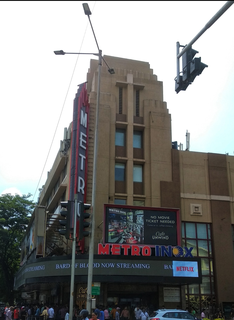
Metro INOX Cinemas is an Art Deco Heritage grade IIA multiplex Movie theatre in Mumbai, India built in 1938. It was built and originally run by Metro-Goldwyn-Mayer (MGM). The main architect of the cinema was Thomas W. Lamb of New York City, and D. W. Ditchburn of Mumbai was the associate architect. It was one of the main sites targeted in the " 2008 Mumbai Attacks "

Smita Patil was an Indian actress of film, television and theatre. Regarded among the finest stage and film actresses of her times and one of the greatest film actresses of all time, Smita Patil appeared in over 80 Hindi, Bengali, Marathi, Gujarati, Malayalam and Kannada films in a career that spanned just over a decade. During her career, she received two National Film Awards and a Filmfare Award. She was the recipient of the Padma Shri, India's fourth-highest civilian honour in 1985. She made her film debut with Shyam Benegal's Charandas Chor (1975). She became one of the leading actresses of parallel cinema, a New Wave movement in India cinema, though she also appeared in several mainstream movies throughout her career. Her performances were often acclaimed, and her most notable roles include Manthan (1977), Bhumika (1977), Jait Re Jait (1978), Aakrosh (1980), Chakra (1981), Namak Halaal (1982), Bazaar (1982), Umbartha (1982), Shakti (1982), Arth (1982), Ardh Satya (1983), Mandi (1983), Aaj Ki Awaaz (1984), Chidambaram (1985), Mirch Masala (1985), Amrit (1986) and Waaris (1988).

Salim–Javed were an Indian screenwriting duo, composed of Salim Khan and Javed Akhtar, working in Bollywood. They are noted for being the first Indian screenwriters to achieve star status, becoming the most successful Indian screenwriters of all time. They are regarded as "Hindi cinema's greatest screenwriters". They worked together on 24 films during 1971–1987, of which twenty were commercially and critically successful films. They worked together on 22 Bollywood films, as well as two Kannada films.
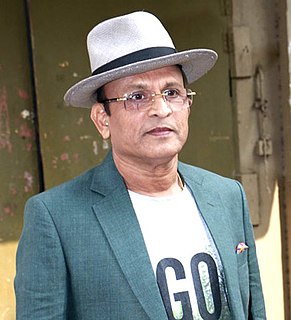
Annu Kapoor is an Indian actor, singer, director, radio jockey and television presenter who has appeared in over a hundred films, as well as television series. His career has spanned over 40 years as an actor, producer, director and singer. Besides acting, he also does a Radio show, named Suhaana Safar With Annu Kapoor which airs on 92.7 big FM. He has won numerous awards in his career, including two National Film Awards, one Filmfare Awards and two Indian Television Academy Awards in varied categories.

Marathi cinema refers to Indian films produced in Marathi, the language of the state of Maharashtra, India. Based in old Mumbai, it is the oldest and pioneer film industry of Indian cinema. The first Marathi film to be released in India was Shree Pundalik by Dadasaheb Torne on 18 May 1912 at Coronation Cinematograph, Mumbai. and a Marathi crew who were performing Marathi and Sanskrit Sangeet natikas (musicals) and plays in Marathi at that period.

Anupama Chopra is an Indian author, journalist, film critic and director of the MAMI Mumbai Film Festival. She is also the founder and editor of the digital platform Film Companion which offers a curated look at cinema. She has written several books on Indian cinema and has been a film critic for NDTV, India Today, as well as the Hindustan Times. She also hosted a weekly film review show The Front Row With Anupama Chopra, on Star World. She won the 2000 National Film Award for Best Book on Cinema for her first book Sholay: The Making of a Classic. She presently critiques movies and interviews celebrities for Film Companion.

Dr. S. M. Pandit was one of the most popular and much sought-after painters of his times, especially in the school of Realism in contrast to the contemporaneous net-traditionalist Bengal Renaissance and other Indian modern art movements. Most of his subjects oscillated between events from classical Indian literature including the Ramayana, the Mahabharata, the Puranas, and the contemporary cinema of his times. He infused a rare blend of artistic virtuosity and filmi glamour to his portrayal of romantic characters like Radha-Krishna, Nala-Damayanti, and Viswamitra-Menaka as also the many heroes and heroines of Hindi cinema. In addition to his critically acclaimed masterpieces he also illustrated many popular film posters, film magazines and various other publications in what can collectively be termed as calendar art. His works remain hugely popular even today. His mythological paintings and calendar art have been collected widely. He is also widely celebrated in the Indian calendar industry for his "realistic" depiction of themes from Hindu mythology. In these paintings he emphasised the physical forms of the heroes, heroines, gods and goddesses in marked contrast to traditional and classical styles of Indian painting. In his paintings, Pandit depicted his subjects as handsome, muscular, valorous men and sensuously beautiful, voluptuous women set in surroundings suggestive of cinema settings and sceneries.

Vidyut Jammwal is an Indian actor, martial artist and stuntman who predominantly works in Hindi-language films. Best known for his roles in action films like Commando series, he is a trained martial artist and is also known as "The New Age Action Hero of Bollywood". He had studied the art of kalaripayattu, an Indian martial art, since at the age of three. He is a recipient of several awards including 1 Filmfare Award.
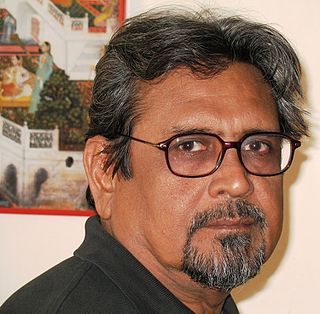
Amrit Gangar is an Indian film scholar, historian, critic, curator and writer from Mumbai, Maharashtra, India.
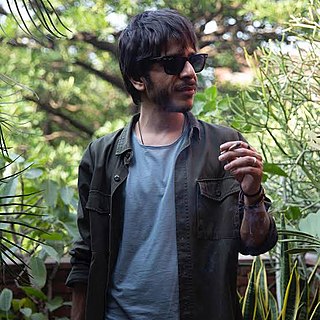
Shashank Arora is an Indian actor, musician and screenwriter. He is known for his roles in Titli (2014), Brahman Naman (2016), Moothon (2019) and Made in Heaven (2019). He is the only Indian actor to have two films compete at Cannes, Sundance, Berlin, Toronto and Locarno film festival.

Daku is a pseudonymous graffiti artist from Delhi, India. Active since 2008, he painted art in several cities across India commenting on social and political issues.
Yantr is a pseudonymous graffiti artist from Delhi, India. Yantr is a Sanskrit word which literally means "machine".
Gopal Balwant Kamble, professionally known as G. Kamble was an Indian painter known for painting Bollywood movie posters and realist portraits of people from Maharashtra.














